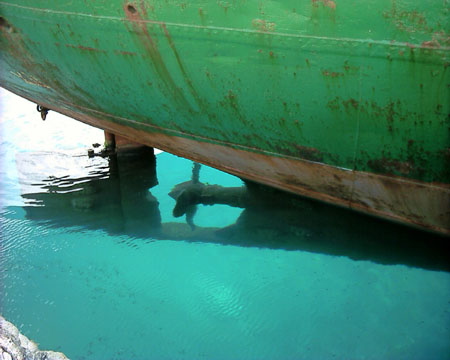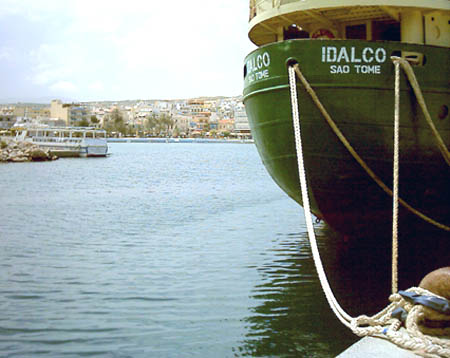
Two views of a ships hull in Sitea harbour, Crete

Above photos Copyright © 2002 Dick Raynor
The top picture shows the stern of a ship in a harbour. Looking steeply down into the 10 m deep water the propeller and rudder are clearly visible. The second picture was taken just a few metres away, and much less is visible. Looking across to the ferry boat, none of its underwater parts are visible at all. Why is this?
When we "see" something, we are receiving light waves either emitted by or reflected from that object. When that object is under the surface of the water, and we are above that surface, some special physics comes into play to determine what we see. Light waves travel more slowly in water than in air, and rays are bent as they pass through the boundary between the two substances. Furthermore, some light is reflected off the surface, and some is usually refracted through it - it all depends on the angle at which the ray strikes the surface - called the "angle of incidence". This is marked at "i" in the borrowed diagram below.
When "i" is small - the light is passing nearly straight upwards, and nearly all of it passes through the surface into the air. Note, however, that it is not in the same line as it approached the surface - it is bent away from the vertical - "refracted away from the normal to the surface" is how a physicist might put it. A simple math formula, part of Snell's Law, states that 1sin r = 1.33 sin i where 1.33 is the refractive index of water, and 1 is the refractive index of air - or near enough.
This is great - an easy way to see how much the refracted angle increases as the light ray - part of an image of an underwater object - deviates from the vertical. I will add a few examples for those who don't have calculators handy ( start>programs>accessories>calculator>view>scientific...will probably get you to yours)
(example: enter 10, sin, times,1.33,=, inv, sin...and up pops 13.35 as the answer)
Angle of incidence i (degrees)
angle of refraction r (degrees)
5
6.66
10
13.35
20
27.05
30
41.68
35
49.71
40
58.75
45
70.12
46
73.08
47
76.58
48
81.25
48.5
85.94
48.7
87.68
48.75
89.41
What's happened?
When the angle of incidence reaches just less than 49 degrees, the light is being refracted so much that it doesn't pass through the water surface at all, but is reflected back under the surface. This is called "total internal reflection".
What does this mean?
Light from, or "images of", underwater objects which are at angle greater
than 49 degrees to the observed point on a smooth water surface will not
be visible above the surface.
So what can you see when looking across a water surface?
So far, I have been discussing light from objects beneath the
surface becoming visible above the surface. This light - these images
- will becoming mixed in with light reflecting off the surface of
the lake, and we need to talk a little about this.
Surface Reflection
Put simply, light arriving at a water surface at angles of incidence less than about 50 degrees ( ie fairly straight on) mostly penetrates the water and gets absorbed. As the angle to the vertical increases above 50 degrees, the percentage reflected rises steeply, and so light from objects low down (say less than 20 degrees above the horizon) is mostly reflected from the surface, and so is there for you to see.
So, as you stand at the lake shore and look down into the water at your feet at a steep angle, you can see the bottom, and a weak reflection of the sky above you. As you raise your head and cast your gaze further out, you lose sight of the bottom quite quickly ( even in shallow water like a paddling pool) and can see a reflection of the sky and perhaps the far shore. Now you know why.
Why are you telling me this?
Some people think that they can see submerged parts of monsters in
some films and still photographs taken over the years. If these were taken
from low angles I think this is very unlikely to be the case.